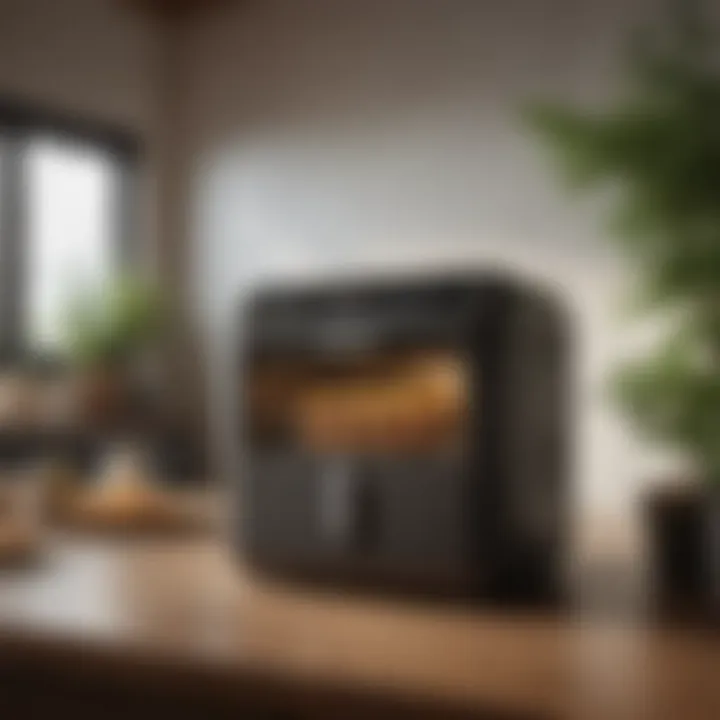Determining the Optimal Size of Air Fryers


Intro
Selecting the right size of an air fryer can greatly influence both cooking efficiency and the overall culinary experience. With various models available, the decision-making process can be overwhelming. This article aims to simplify that journey by dissecting key factors related to air fryer sizes, capacities, and their appropriateness for diverse kitchen environments. Whether you are a busy parent, a culinary enthusiast, or someone living in a smaller space, understanding the nuances of air fryer sizing can lead to better meal preparation and lifestyle satisfaction.
In the sections that follow, we will explore the different sizes of air fryers, how these sizes connect with household needs, cooking styles, and the physical kitchen space. We will also pinpoint specific scenarios and preferences to ensure an optimal fit for your requirements. The goal is to empower readers to make informed choices that harmonize their cooking activities with their day-to-day lives.
Understanding Air Fryer Sizes
Understanding the sizes of air fryers is vital for making an informed purchasing decision. Air fryers come in various sizes, each catering to different cooking needs and kitchen environments. The optimal size impacts cooking efficiency, meal preparation time, and overall satisfaction with the appliance. Failure to consider these aspects can lead to regrettable choices, often resulting in an underutilized or over-bulky kitchen gadget. Thus, knowing the distinctions in sizes helps consumers match their preferences, kitchen layout, and household requirements.
Prolusion to Air Fryers
Air fryers are compact, kitchen appliances designed to cook food quickly using hot air circulation. They provide a healthier alternative to deep frying. Many people appreciate them for their ability to produce crispy textures without excessive oil. This feature contributes to their growing popularity among health-conscious consumers. However, understanding the size options available will help users maximize the benefits of this technology.
Types of Air Fryers
The air fryer category includes several types, each with a unique design and function. The most common types are traditional basket-style air fryers, toaster oven air fryers, and instant pot air fryers. Each has its distinct capacity and usage.
Traditional basket-style air fryers
Traditional basket-style air fryers are the most recognized variant on the market. They typically feature a basket that holds food while hot air circulates around it, promoting even cooking. This design is often compact, making these models suitable for small kitchens. The ease of use is a major factor for their popularity. Users can quickly set the temperature and time. However, one drawback can be limited cooking space, affecting the number of portions that can be prepared at once.
Toaster oven air fryers
Toaster oven air fryers combine the functionality of a toaster oven with air frying capabilities. This dual-purpose design allows users to bake, toast, and air fry, making them versatile appliances. One key characteristic is their larger cooking space compared to traditional basket-style versions. Users appreciate this feature when preparing meals for families. Nevertheless, they may take up more countertop space, which could be a factor in smaller kitchens.
Instant pot air fryers
Instant pot air fryers are unique as they incorporate air frying technology into multi-cookers. The primary advantage is versatility; they can pressure cook, slow cook, and perform various cooking methods. Because of this, consumers benefit from an all-in-one solution, reducing the number of appliances required in the kitchen. However, some may find that the air frying function does not perform as efficiently as standalone air fryers, potentially leading to varied cooking results.
Common Air Fryer Sizes
Understanding the various sizes of air fryers is pivotal for any consumer looking to make a purchase that aligns well with their cooking needs and kitchen space. Selecting an air fryer that fits your lifestyle, household size, and available storage can significantly optimize your cooking experience. The common sizes available in the market cater to different user bases; knowing these sizes helps in leveraging their strengths effectively.
Small Air Fryers
Typical capacity
Small air fryers usually have a typical capacity ranging from 1.5 to 3 quarts. This size can accommodate a meal for one or two people. A small air fryer can be a prudent choice for individuals who live alone or couples wanting to prepare quick meals without wastage. Its limited capacity means it uses less energy, contributing to efficiency and cost-effectiveness. However, it does restrict the range of meals that can be prepared at one time, which can be a downside for those who enjoy entertaining.
Ideal usage scenarios
Small air fryers are ideal for quick, single-serving meals like fries, wings, or veggies. They are especially useful in small kitchens where storage is limited. Their compact designs allow them to be easily stored in cabinets or on countertops. A unique feature of these small units is their portability, making them a great option for students or individuals frequently moving. On the flip side, for families or larger gatherings, their size can be limiting, necessitating multiple batches which may not be practical.
Medium Air Fryers
Typical capacity
Medium air fryers typically have a capacity ranging from 3.5 to 5.5 quarts. This size offers a balance between usability and space efficiency. They are suitable for small families or individuals who enjoy meal prep. Users find medium air fryers provide enough space to cook a variety of dishes simultaneously or prepare larger portions. While offering compatibility with various recipes, the trade-off may come in the form of counter space they require.
Ideal usage scenarios
Medium air fryers are great for preparing family meals or batch cooking. They accommodate meals like casseroles or larger quantities of proteins which can be beneficial for meal prepping. The versatility of these models is a significant advantage, allowing users the flexibility to experiment in the kitchen more conveniently. However, they may not fit comfortably in every kitchen, especially in compact urban settings.
Large Air Fryers
Typical capacity


Large air fryers typically range from 6 quarts and above. This size is suitable for those who frequently cook for larger families or entertain guests regularly. The increased capacity allows for cooking multiple items at once or preparing whole meals effectively. Larger air fryers also tend to come equipped with additional features such as multiple baskets or multiple functions, providing a comprehensive cooking experience.
Ideal usage scenarios
Large air fryers excel in situations like family gatherings or parties where considerable food preparation is necessary. They are capable of accommodating large cuts of meat or generous servings of vegetables, making them highly functional for batch cooking. While they may require ample storage space, their multifunctional capabilities can justify the investment for serious cooks. The main drawback, however, is that their bulk can be a challenge for users with limited kitchen space or those who prefer a minimalist appliance approach.
Factors to Consider When Choosing Size
When selecting the optimal size of an air fryer, it is essential to consider multiple factors that impact cooking efficiency and user experience. These factors can significantly affect meal preparation and the overall satisfaction with the appliance. By understanding household size, cooking habits, and available kitchen space, individuals can make informed decisions tailored to their specific situations. This holistic approach can lead to better cooking outcomes and a more enjoyable culinary experience.
Household Size
Single individuals
For single individuals, air fryer size is often dictated by a desire for convenience and efficiency. A smaller air fryer, typically around two to three quarts, is sufficient for preparing meals for one person. This size reduces energy consumption and cooking time, making it a popular choice. Additionally, smaller air fryers are less cumbersome, meaning they can fit comfortably on a countertop without taking up excessive space. However, one limitation is that you may have to cook in batches if preparing multiple servings or dishes.
Couples
Couples benefit from mid-sized air fryers with a capacity of three to five quarts. This size accommodates meals for two with ease, allowing for a variety of cooking methods and greater flexibility in meal options. A mid-sized model is advantageous because it can handle both small dinners and more elaborate meals when cooking together. The downside, however, is that some models might still be a little too small for hosting guests or cooking larger portions, which could necessitate adjusting cooking strategies.
Families
For families, larger air fryers with a capacity of five to eight quarts are ideal. This size allows home cooks to prepare substantial meals, such as whole chickens or large batches of french fries, that satisfy multiple family members. The enhanced capacity makes cooking for larger gatherings more manageable. A key feature of larger air fryers is the ability to cook multiple types of food simultaneously, which can be a significant advantage during busy weeknights or special occasions. However, these units require more storage space and can sometimes dominate kitchen counters.
Cooking Habits and Preferences
Types of meals prepared
The types of meals a person typically prepares can influence the choice of air fryer size. If one often cooks simple snacks or reheats leftovers, a smaller unit may suffice. On the other hand, if meals often include multi-component dishes or larger proteins, a larger model becomes essential. Choosing the right size based on meal types can enhance cooking efficiency. However, it is crucial to balance cooking preferences with available kitchen space to avoid overcrowding.
Frequency of cooking
Individuals who cook frequently benefit from larger air fryers as these can facilitate batch cooking. Higher frequency cooking often means preparing larger quantities, which larger air fryers can accommodate easily. A critical aspect of choosing based on cooking frequency is the ease of use and cleanup that different sizes offer. Smaller air fryers are quick to clean, while larger units may have more parts to wash, potentially discouraging spontaneous meal preparations.
Kitchen Space and Storage
Countertop availability
The availability of countertop space is a vital consideration when selecting an air fryer. Limited kitchen counter space often necessitates a smaller model, which is more manageable and can easily be stored when not in use. If counter space is abundant, homeowners might opt for larger models that offer more cooking flexibility. An often overlooked feature is the weight and footprint of the model, which also affects how easily it can be moved and stored. Ultimately, kitchen layout and daily routines should guide the decision on size.
Cabinet space
Lastly, cabinet space is a crucial factor, particularly for those who have limited countertop availability. If storing the air fryer out of sight is a priority, ensure that the chosen model will fit comfortably in cabinets. Remember that larger models may not fit in kitchen cabinets, which could lead to clutter on countertops. Assessing both the height and dimensions of the air fryer against existing cabinet space will ensure that it can be easily accessed when needed without undue hassle.
Capacity vs. Performance
When selecting the right air fryer, understanding the balance between capacity and performance is essential. Capacity refers to the volume of food an air fryer can hold, typically measured in quarts. Performance encompasses how efficiently it cooks food within that space. A larger capacity might seem appealing for family meals, but its effectiveness in cooking food thoroughly should not be overlooked. This section delves into these aspects, focusing on how capacity and performance impact your cooking experience.
Understanding Capacity Metrics
Quarts explained
Quarts provide a standard unit for measuring the capacity of air fryers. The capacity usually ranges from two quarts in smaller models to six or more quarts in larger units. A key characteristic of quarts is how they give a clear picture of an air fryer's cooking potential. Users can easily gauge if a particular model will meet their needs based on the number of servings required. Often, smaller models are beneficial for individuals or couples, making efficient use of space without wasting energy. However, larger units can accommodate bigger meals, which is advantageous for families or gatherings.
Understanding quarts helps in selecting an air fryer that is neither too big nor too small. Each quart can often serve one to two servings efficiently. Therefore, considering the number of meals you'll typically prepare is crucial when choosing the right size.
Interpreting manufacturer claims


Manufacturers often advertise their air fryers with specific claims regarding capacity. These claims can sometimes mislead consumers. The key challenge here is understanding what constitutes the "cooking capacity." Some brands may include the maximum volume without considering how food may need to be arranged for optimal cooking. Thus, interpreting these claims accurately is essential. It allows users to make informed decisions based on realistic expectations rather than attractive packaging.
A unique feature of interpreting manufacturer claims is the differentiation between usable capacity and overall capacity. The usable space is what significantly matters for effective cooking. Misleading advertisements may lead buyers to choose an air fryer that does not match their needs adequately, causing frustration down the line.
Efficiency in Cooking
Cooking times for various sizes
Cooking times vary based on the size of the air fryer. Smaller models typically cook faster due to the compact space that allows heat to reach food more efficiently. Conversely, larger air fryers can take longer to cook food evenly, especially at full capacity. This characteristic impacts the overall cooking experience, particularly for those who frequently prepare meals.
The advantage of understanding cooking times ensures that users can plan their meals effectively. If a user owns a larger air fryer but primarily cooks for one, it may lead to unnecessary delays. Hence, knowing a model’s cooking speed can help in making more practical choices for daily cooking needs.
Air circulation effectiveness
Air circulation is crucial for even cooking in an air fryer. The design and technology of the air fryer affect how hot air circulates around the food. Efficient air circulation results in crispy exteriors and tender interiors. Some larger models might struggle with air flow if they are filled beyond capacity, leading to unevenly cooked meals.
An effective air circulation system not only enhances cooking quality but also reduces preparation time. Users can maximize their air fryer's potential by ensuring they do not overcrowd the basket. Understanding how to leverage air circulation effectively can elevate the cooking experience, making it essential for those who value texture and flavor in their meals.
Key Takeaway: When selecting an air fryer, consider both capacity and its performance. A model that fits your cooking style should balance the necessary size for your meals with its ability to cook efficiently.
Recommendations Based on Use Cases
Selecting the right air fryer size necessitates an understanding of individual cooking needs. This section focuses on how different use cases dictate specific air fryer sizes. It addresses practical aspects and highlights the benefits of choosing the appropriate capacity.
Meal Preparation for One
Best size suggestions
For individuals cooking primarily for themselves, selecting an air fryer with a smaller capacity is optimal. Generally, a model in the range of 2 to 4 quarts is suitable. These compact air fryers allow personal meal prep without excessive energy consumption or wasted food. They stand out because they are lightweight and easy to store. A key characteristic is their ability to deliver crispy textures without large quantities of ingredients. Smaller models are beneficial because they take up less countertop space and often have a lower price point.
However, one must consider that these size constraints can limit the versatility. For instance, larger recipes or multiple servings may need to be adjusted. An advantage is their efficiency in heating, making them quicker to preheat and cook.
Efficiency of smaller models
Smaller air fryers excel in efficiency, making them an attractive choice for individuals. These models generally heat up rapidly and circulate hot air effectively due to reduced cooking space. This enables shorter cooking times compared to larger units, enhancing convenience for those with busy lifestyles. A unique feature is their ability to prepare quick meals, from frozen snacks to sautéed vegetables, in a fraction of the time needed for traditional cooking methods.
One disadvantage is that when entertaining or meal prepping for guests, they may require multiple batches. The smaller capacity can limit variety in meal preparation at once due to space.
Family Meal Preparation
Optimal size recommendations
For family meal preparation, a larger air fryer is recommended, typically in the 4 to 8 quart range. This capacity allows for cooking substantial portions, catering to several family members at once. A key characteristic here is the ability to manage larger quantities of food, which significantly enhances meal prep efficiency. Many families find this beneficial as it reduces cooking time and effort associated with multiple devices.
The versatility of larger units cannot be overstated; they are suitable for various recipes and cooking styles. However, one should note that these units can take up considerable space and may be heavier. The trade-off comes down to storage and portability versus the ability to cook for more people in less time.
Dual cooking capabilities
Dual cooking capabilities in selected larger models allow for cooking different foods simultaneously. This feature is advantageous for families with diverse eating preferences. For example, one side can be used for main dishes while another prepares side items. This encourages more balanced meals without the hassle of using multiple kitchen appliances.
Additionally, these capabilities can lead to a more enjoyable cooking experience. Families can save time during busy weeknights and prepare a more varied diet. Nevertheless, the complexity of these models may deter some users who prefer simplicity in their cooking appliances.
Entertaining and Batch Cooking
Size requirements for larger gatherings
When entertaining or batch cooking, the size of an air fryer can profoundly affect the experience. Typically, air fryers exceeding 8 quarts are appropriate for larger gatherings. These larger models allow for cooking significant amounts of food simultaneously, ideal for parties, celebrations, or family reunions. A key characteristic is their ability to reduce cooking time by enabling batch preparation.


This is advantageous, as it saves both time and effort. However, users should be cautious about the space occupation in the kitchen. Larger models may not fit everyone’s kitchen layout, which can be a drawback for those with limited kitchen space.
Advantage of multifunctional units
Multifunctional air fryers combine the benefits of an air fryer with other cooking methods, such as baking, roasting, and toasting. This integration can enhance kitchen efficiency and reduce the need for multiple appliances. Users find this type beneficial, especially in smaller kitchens where space is limited. A unique aspect of multifunctional units is their ability to serve diverse cooking needs without sacrificing quality.
However, these models can often be more expensive and may require a learning curve to master various functions. Understanding how to use each feature may take time, but the versatility they offer can make the investment worthwhile.
Maintenance and Usability Considerations
Maintaining an air fryer involves understanding its usability features. The ease of cleaning and operation play key roles in ensuring a pleasant cooking experience. A well-maintained air fryer can prolong its lifespan, deliver consistent results, and simplify your culinary adventures. When choosing an air fryer, consider how maintenance affects your regular use and enjoyment of the appliance.
Ease of Cleaning
Non-stick Coatings
Non-stick coatings are a significant aspect of air fryers. They reduce the need for excessive oils and fats, allowing for healthier meal preparation. Non-stick surfaces ensure that food releases easily after cooking. This characteristic makes them popular among home cooks. Their slick surface can also contribute to easier cleaning.
One unique feature of non-stick coatings is their resistance to food sticking, which minimizes the mess. However, these coatings may wear over time or become damaged if metal utensils are used. Therefore, users must be cautious and use wooden or silicone utensils to preserve the coating. This aspect of non-stick surfaces can be an advantage for many who prefer fuss-free meal preparations.
Dishwasher-safe Components
Dishwasher-safe components are a sizable advantage in ease of cleaning. This feature allows users to simply place removable parts into the dishwasher. It removes the tedious task of handwashing, saving both time and effort. This solid characteristic appeals to those having busy lifestyles or large families.
Moreover, the convenience of dishwasher-safe parts enhances the overall usability of air fryers. However, not all parts may be dishwasher safe. Users should carefully review the manufacturer’s information to ensure compliance. While dishwashers offer convenience, washing by hand could sometimes offer a more thorough clean. Understanding which parts are safe for a dishwasher can significantly improve the maintenance experience.
Ease of Use Features
Digital Controls vs. Manual Dials
Digital controls offer modern convenience for air fryer users, providing precise temperature and timing options. This feature simplifies the cooking process, leading to consistent outcomes. Many users find digital interfaces intuitive, allowing for smoother interactions while cooking.
On the other hand, manual dials can appeal to users preferring simplicity. They typically feature fewer complications and can be easier to operate for those not familiar with technology. Both options have their advantages; the choice often depends on individual preferences regarding usability and comfort with technology.
Smart Technology Integration
Smart technology integration in air fryers adds an advanced layer of usability. This feature connects the appliance with a smartphone or smart home systems, allowing remote monitoring and control. Users may take advantage of recipe apps to enhance their cooking experience.
Yet, this capability can also introduce complexity. Users not familiar with smart devices might face a learning curve. Some may find traditional air fryers sufficient for their needs, avoiding potential technical issues. The decision depends on comfort with technology and the desire for enhanced functionality.
Consider your preferences regarding cleaning, usability, and technology when choosing an air fryer. Each aspect contributes to a satisfactory cooking experience, making your kitchen endeavors more enjoyable.
In summary, maintenance and usability features can greatly affect the decision-making process when choosing an air fryer. Understanding these considerations will lead to an informed purchase and a more satisfying cooking journey.
Epilogue: Making an Informed Decision
In selecting the optimal size of an air fryer, one must carefully consider multiple factors that affect personal cooking habits and capacity needs. The decisions made at this juncture will indeed influence not only culinary outcomes but also usability and storage within one’s kitchen environment. It is paramount to approach this matter with clarity and an understanding that the correct size can improve cooking efficiency, enhance meal quality, and ultimately lead to a better user experience.
Important considerations involve evaluating household size, frequencies of meal preparation, and specific types of dishes one usually cooks. Recognizing whether the air fryer will serve as a principal cooking tool or a supplement to existing kitchen appliances can guide the decision toward a size that offers the best balance of performance and convenience.
"The right air fryer can transform how you cook, making it essential to select one aligned with your culinary needs."
Thus, before making a final choice, reflect on the factors and how they resonate with personal lifestyle and kitchen dynamics. This ensures the air fryer is not just an addition, but a relevant, functional centerpiece in meal preparation.
Recap of Key Considerations
When determining the size of an air fryer, several critical elements merit consideration:
- Household Size: Understanding how many individuals will rely on the air fryer can dictate the capacity needed. Smaller models may suffice for one or two people, whereas larger families might require spacious options.
- Cooking Frequency: Assess how often the air fryer will be used. Daily usage may suggest a need for a versatile, larger device, while occasional cooks may prioritize compact size.
- Kitchen Space: Evaluate the available countertop and storage space. A good air fryer will fit comfortably without cluttering valuable cooking surfaces.
- Meal Types: The nature of meals to be prepared—whether quick snacks, large meals, or desserts—should influence the choice of size. A multifunctional unit might offer better value and versatility.
Final Thoughts on Air Fryer Selection
Choosing the right size of an air fryer requires weighing numerous personal and environmental factors against the units available in the market. It is not merely a matter of picking a product from a list; instead, it’s about whether that product fits seamlessly into your life and culinary preferences. Consider specific situations, such as whether the appliance is meant for solo dining, family gatherings, or entertaining friends.
Having thoroughly analyzed the options, practical insights will lead to a more thoughtful purchase decision. Researching various models and reading reviews from users can offer further clarity. Integrate your cooking habits with the right model to elevate meal preparation to new heights of efficiency and enjoyment. An informed choice will foster a satisfying culinary experience, making the air fryer a valuable ally in the kitchen.















